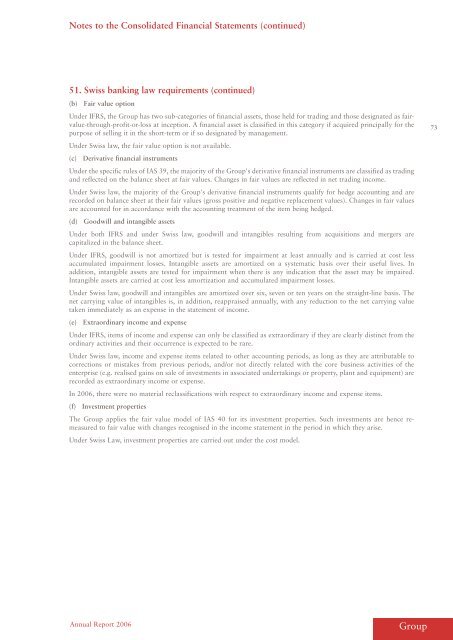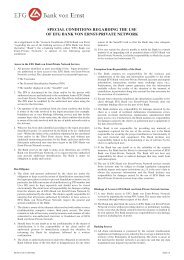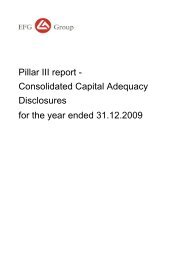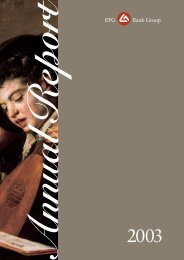Annual Report - EFG Bank Group
Annual Report - EFG Bank Group
Annual Report - EFG Bank Group
You also want an ePaper? Increase the reach of your titles
YUMPU automatically turns print PDFs into web optimized ePapers that Google loves.
Notes to the Consolidated Financial Statements (continued)<br />
51. Swiss banking law requirements (continued)<br />
(b) Fair value option<br />
Under IFRS, the <strong>Group</strong> has two sub-categories of financial assets, those held for trading and those designated as fairvalue-through-profit-or-loss<br />
at inception. A financial asset is classified in this category if acquired principally for the<br />
purpose of selling it in the short-term or if so designated by management.<br />
Under Swiss law, the fair value option is not available.<br />
(c) Derivative financial instruments<br />
Under the specific rules of IAS 39, the majority of the <strong>Group</strong>'s derivative financial instruments are classified as trading<br />
and reflected on the balance sheet at fair values. Changes in fair values are reflected in net trading income.<br />
Under Swiss law, the majority of the <strong>Group</strong>'s derivative financial instruments qualify for hedge accounting and are<br />
recorded on balance sheet at their fair values (gross positive and negative replacement values). Changes in fair values<br />
are accounted for in accordance with the accounting treatment of the item being hedged.<br />
(d) Goodwill and intangible assets<br />
Under both IFRS and under Swiss law, goodwill and intangibles resulting from acquisitions and mergers are<br />
capitalized in the balance sheet.<br />
Under IFRS, goodwill is not amortized but is tested for impairment at least annually and is carried at cost less<br />
accumulated impairment losses. Intangible assets are amortized on a systematic basis over their useful lives. In<br />
addition, intangible assets are tested for impairment when there is any indication that the asset may be impaired.<br />
Intangible assets are carried at cost less amortization and accumulated impairment losses.<br />
Under Swiss law, goodwill and intangibles are amortized over six, seven or ten years on the straight-line basis. The<br />
net carrying value of intangibles is, in addition, reappraised annually, with any reduction to the net carrying value<br />
taken immediately as an expense in the statement of income.<br />
(e) Extraordinary income and expense<br />
Under IFRS, items of income and expense can only be classified as extraordinary if they are clearly distinct from the<br />
ordinary activities and their occurrence is expected to be rare.<br />
Under Swiss law, income and expense items related to other accounting periods, as long as they are attributable to<br />
corrections or mistakes from previous periods, and/or not directly related with the core business activities of the<br />
enterprise (e.g. realised gains on sale of investments in associated undertakings or property, plant and equipment) are<br />
recorded as extraordinary income or expense.<br />
In 2006, there were no material reclassifications with respect to extraordinary income and expense items.<br />
(f) Investment properties<br />
The <strong>Group</strong> applies the fair value model of IAS 40 for its investment properties. Such investments are hence remeasured<br />
to fair value with changes recognised in the income statement in the period in which they arise.<br />
Under Swiss Law, investment properties are carried out under the cost model.<br />
<strong>Annual</strong> <strong>Report</strong> 2006<br />
<strong>Group</strong><br />
73





